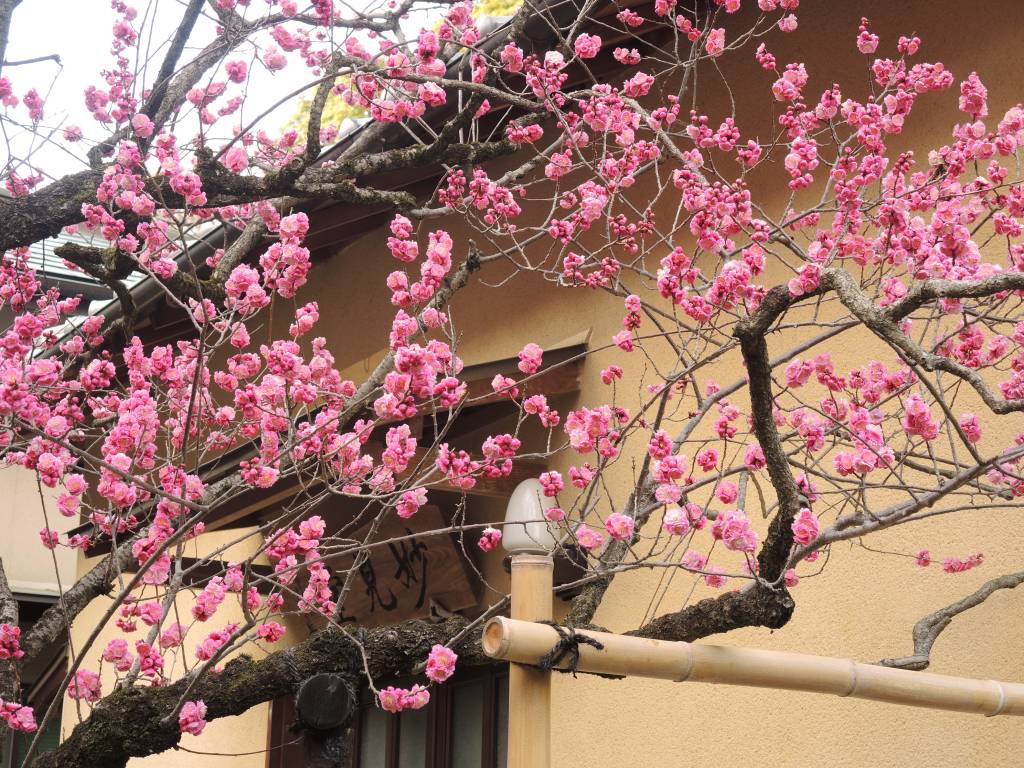合掌
日蓮聖人御入滅750年の報恩事業の一環として、
絵画の作成に取り組んでおります。
仏さまの教えを伝える絵のほか、
六老僧をはじめとする重要人物の肖像画の作成など、
様々な作品を準備しております。
この作品は、橋賢亀(はし かつかめ)さまに依頼した水彩画で、
『ほとけの国(人)』という画題をつけました。
中央の白い蓮と木偶人形に雨が降り注ぎ、
その周りはぼんやりした雰囲気が漂っています。
色の選びのセンスが素敵なので、
綺麗な絵だと思われたのではないでしょうか。
ただ、細かいところまでよく見ていただくと、
崩壊した街のような風景が描かれているのがわかります。
また、いたるところに人骨が転がり、
それに気づくと所々散っている赤色は、
実は血ではないのかと察してしまうではないでしょうか。
焦点の当たっているところがたまたま綺麗に見えているだけで、
実はこの絵の世界そのものは非常に恐ろしく、
荒廃しているのではないかと想像できます。
すると、この作品のメッセージの一つは、
人の世界の残酷さや恐ろしさということになるようにも思えます。
例え私たちがどこで生きようとも、
人間界の闇とも言うべきこの一面から逃れることは不可能でしょう。
しかし、実際のところ、日本は平和であるように思えます。
人の世が危険で苦しいのはわかるものの、
それと比べたら私たちの社会はマシなのでは?
このような意見もあるかもしれません。
しかしこの国は、
依然として年間2万人を超える人間が自分で命を絶ち、
毎年8万人ほどの方が行方不明になります。
無茶苦茶な言い分かもしれませんが、
戦争や災害、あるいはコロナウイルスの犠牲者と、
上の人数を比較してみるとその異常さがよくわかります。
なぜ自分は今までこの10万人の中に入らなかったのか。
その理由は不明であるにもかかわらず、
私たちはつい言語化をしたくなり、
当事者たちのことを「心が弱かった」「運が悪かった」「相談できる人が周りにいなかった」
のような誰にでも言えそうで、
誰にでも当てはまりそうな一、二文で簡潔に説明したがります。
なぜその人がそう選択したのか、
残された私たちには知ることができないはずですのに。
平和に思えるこの国と同様、
世界のどこに行っても人の国は似たような感じでしょう。
どの社会でも人の血は流れ、どの国のどの町もどこか荒んでいるはずです。
そもそも人に生まれた私たちは、
安全で、かつ幸せであることを保障された存在なのでしょうか?
むしろ、人の運命は極めて不安定で危なっかしいのが普通なのではないでしょうか。
自覚の有無は別として、私たちは薄氷の上を歩いているのだと思います。
常に気をつけていたら神経が衰弱してしまうので仕方がないのですが、
あまりに無邪気かつ無神経すぎる自分が怖くなります。
絵の中の汚れた木偶人形のように、
荒れた世界の中で俯くしかなくなるのは、
次は自分なのかもしれません。
バイクで転ぶとか、引き落としの前の日に入金を忘れたとか、
絶対に怒らせてはならない人との約束を違えてしまったなど、
コメディに使えそうなエピソードでも、
冗談では済まない結果に繋がることがあります。
なぜ今日まで無事だったのかが不思議でなりません。
ただ、いつかは倒れるか座り込むことになるでしょうね。
絵の中の人形は、私たち一人一人のいつかの姿なのだと思っています。
ところで、まだ蓮について触れていませんでした。
中央に描かれたひときわ目立つ白蓮華。
これはいったい何でしょうか。
わからなくても、
これが無ければ木偶人形が倒れてしまうことは一目瞭然です。
デクノボーが人間の例えであるならば、
蓮は何の例えなのでしょう。
そして、白い蓮に支えられた木偶人形は、どんな表情をしているでしょうか?
この絵は様々なことを語ってくれていますが、
どう解釈するかはあくまでも見る人に委ねられます。
そしてもう考えていただきたいことがあります。
このデク ノボーは、自分を支える大きな蓮の存在に気づいているでしょうか?
まずこちらの質問に答えを出すことができれば、
先の質問の答えを見つけやすくなるはずです。
本作は、宮沢賢治『雨ニモ負ケズ』を踏まえて作成していただきました。
そもそも人は、雨にも風にも勝つことはできないはずです。
ただ勝てはしないでも負けずにいられるのは、
その人を支える存在のおかげだと思います。
自分を支える大きな存在に確信を持つことができれば、
まだ終わりではないと悟ることができるのかもしれません。
This is a watercolor painting entrusted to Katsukame Hashi.
The title of this painting is Hotoke-no-Kuni (Hito),
or “Land of the Lotus (Human).”
The painting shows a white lotus and wooden figurine in the center in pouring rain,
creating a vague surrounding atmosphere.
The sense of color selection is wonderful,
so you would probably think it is beautiful.
However, if you take a closer look at the details,
you can see that the landscape appears like a destroyed city.
In addition, when you notice human bones rolling all over the place,
you may think that the red scattered about is actually blood.
Although the focus of the painting looks beautiful,
you can imagine that the world
portrayed in the painting itself is very frightening and desolate.
Then, one of the messages of this work seems to be the cruelty and horror of the
terrestrial world.
No matter where we live,
it is impossible to escape from this dark side of the human realm.
However, in reality, Japan seems to be peaceful.
We know that our world is dangerous and painful,
but is not our society better than that?
Some may be of such an opinion.
However, in this country,
more than 20,000 commit suicide
and about 80,000 people go missing every year.
Although it may be a crazy argument,
if you compare the number of victims of war, disaster, or coronavirus,
you can clearly understand the inconsistencies.
Why have I not been among the 100,000 people up to now?
Even though we don’t know the reason for this,
we just want to verbalize it ;
we want to easily dismiss these people in a couple of words,
such as “weak heart,” “bad luck,” or “no one around to talk to.”
We, the rest of us,
cannot know why the person chose to do so.
No matter where you go in the world,
countries of people all give the same impression of being peaceful.
Human blood flows in every society, and every town in every country
contains ruin somewhere.
Are we guaranteed safety and happiness in the first place?
Oppositely, it is normal for a person's destiny to be extremely unstable and dangerous.
Whether we are aware or not,
we are always walking on thin ice.
If you are always careful,
you will always be tense;
you will always be afraid you are being naive and insensitive.
Like the dirty wooden figurine looking down on a desolate world in a painting,
I may be the next one to meet such a fate.
Even humorous episodes such as falling on a motorcycle,
forgetting a deposit the day before the withdrawal,
or failing to keep a promise to someone who tends to get easily angered,
can lead to something that is not funny.
It is not strange that you have been safe up to now.
However, someday you will fall down or sit down.
I think the figure in the picture is the figure of each of us someday.
By the way, I have not mentioned lotus yet.
A stand-out white lotus flower drawn in the center.
What is this?
Even if you do not know,
it is obvious at a glance that if weren’t for this,
the wooden figurine would collapse.
If the figurine is a human analogy, what is the lotus analogy?
What is a wooden figurine supported by a white lotus supposed to symbolize?
This painting tells us many things,
but how to interpret it is up to the viewer.
I would like you to think about it.
Is this figurine aware that it is supported by a huge lotus?
If you can answer this question first,
it will be easier to find the answer to the previous question.
This work was created based on Kenji Miyazawa's "Ame ni-mo Makezu.”
A human being is not expected to win out over wind or rain.
You don't win, but you also don't lose.
I think it is by merit of the existence that supports the person.
If you can be confident in the existence that supports you,
you may realize that you still have a way to go.
檀信徒の方はこちらもご覧ください。
よくある質問をまとめております。
ご相談の際は、お寺にお越しになる前にご予約をお願いします。


